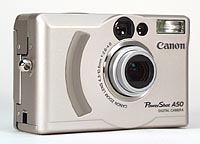
|


|
* |
1280x960 resolution |
|
* |
Compact, rugged case |
|
* |
2.5x Optical Zoom Lens |
|
* |
Great low-light ability (up to ISO400) |
|
* |
Panorama support, including 2x2 matrix! |
|
|

Canon PowerShot A50 Review Index:
Test Results
As always, in Imaging Resource reviews, we encourage you to
examine the Sample Pictures for the
PowerShot A50, and form your own conclusions about its suitability
to your needs! Our comments here are a condensed version of those
on the Pictures Page itself.
The previous A5 digicam from Canon was a great little camera,
and it produced excellent images relative to other cameras on
the market at the time of its introduction. We were surprised
then, by how much better photos from the A50 looked! The PowerShot
A50 produced some of the best-looking images we've seen from
any 1.3 megapixel camera to date! Colors are bright and saturated,
yet difficult "memory" colors like Caucasian skin tones
are natural and not over-saturated. Resolution is excellent,
and the camera's low-light capability is excellent as well.
The only criticisms we could find on the PowerShot's images is
that they tend to be a bit contrasty, losing highlight detail
a bit faster than some of the competition, and the camera really
likes greens. - This last characteristic shows somewhat in the
"House" and "Far" shots, in which the grass
adopts an unnaturally bright hue. Other than the greens however,
color from the PowerShot A50 was exceptionally accurate, with
excellent saturation in strong primaries, but superb handling
of delicate pastels as well.

|
 |
|
Our "Far" shot, saved with
the in-camera JPEG compression. |
The identical shot, captured in the
camera as an uncompressed "CRW" file, later opened
with the TWAIN driver, and saved as a high-quality JPEG image. |
We were very interested to find though, that the TWAIN driver
(and presumably the Photoshop acquire module as well) handles
color from the CCD Raw files rather differently. Here's a couple
of samples of the "Far" shot, both direct from the
camera's own JPEG, and as filtered through the TWAIN driver,
from the "CRW" uncompressed raw CCD data file. (You
can click on either thumbnail to view a full-resolution image.)
The differences are quite striking, with the CRW version having
color that we'd judge as being closer to the original. Interestingly,
the TWAIN/CRW file also appears to do a better job of holding
highlight detail, as seen in the fine detail of the pine-tree
branches against the sky. Overall, the TWAIN/CRW handling of
color and tone appears very similar to that of Canon's higher-end
Pro70 digicam. This is a very interesting behavior, in that one
camera can be used to produce two very different color/tonal
responses. We'd say that the camera's "native" color
is well-suited to most non-professional uses, in that it results
in very bright, snappy images, with well-saturated colors and
great visual appeal. On the other hand, the TWAIN/CRW route produces
images that are likely to be more pleasing to professionals,
looking for more "accurate" color, and lower contrast
overall. We've been waiting to see one of the digicam manufacturers
produce a camera with options for multiple "looks"
in its pictures (sort of like the differences between major film
emulsions): Perhaps the PowerShot A50 is a first move in that
direction by a major manufacturer. Regardless of whether the
provision for two entirely different color/tone balances in the
same camera was accidental or deliberate, we applaud Canon for
providing it! We look forward to the day when users can select
from a range of "film types" in their digital cameras,
matching color- and tonal handling to their specific tastes and
picture-taking needs
Turning to more conventional aspects of image quality, the PowerShot
A50 performed very well in the resolution department, with visual
resolution approaching 650 lines per picture height horizontally
and 600-650 vertically: Clearly the equal of any other 1.3 megapixel
digicam on the market (June, 1999)(!) We also found the A50's
lens to be of unusually high quality, producing almost no chromatic
aberration regardless of focal length, and with only moderate
barrel distortion (1.1%) at the wide-angle end of the lens' range,
dropping fairly rapidly to zero as the lens was zoomed toward
the telephoto end.
As noted earlier, the optical viewfinder
on the A50 is a bit "looser" than most, showing only
80% of the final image area at the wide-antle end, and 78% in
telephoto. The LCD viewfinder also crops the image area slightly,
showing about 95% of the final image in both telephoto and wide-angle
modes. The overall view of the optical finder is biased upward
slightly across the focal length range, while that of the LCD
is well-centered. You'll thus need to shoot a few frames to develop
a sense of what's actually being recorded, particularly when
using the optical finder. Flash uniformity is somewhat lacking
at the wide angle end of the focal length range, but very good
at the telephoto end.
Macro performance is about in the middle of the pack, with a
minimum capture area of 3.5 x 2.6 inches (88 x 66mm) - some recent
digicams have extended macro performance into the "micro"
arena, but the A50's capabilities are likely to be sufficient
for all but the most zealous of macro shooters.
The PowerShot A50 did very well in our low-light tests, producing
very good pictures down to a light level of EV7 (that's pretty
dark), and "usable" images as far down as EV 5. (These
latter ones required substantial adjustment in Photoshop after
the fact, however.) The ISO 400 rating of the A50's low-resolution
mode seemed to produce shorter exposure times, but not any decrease
in the ultimate low-light limit.
|

|